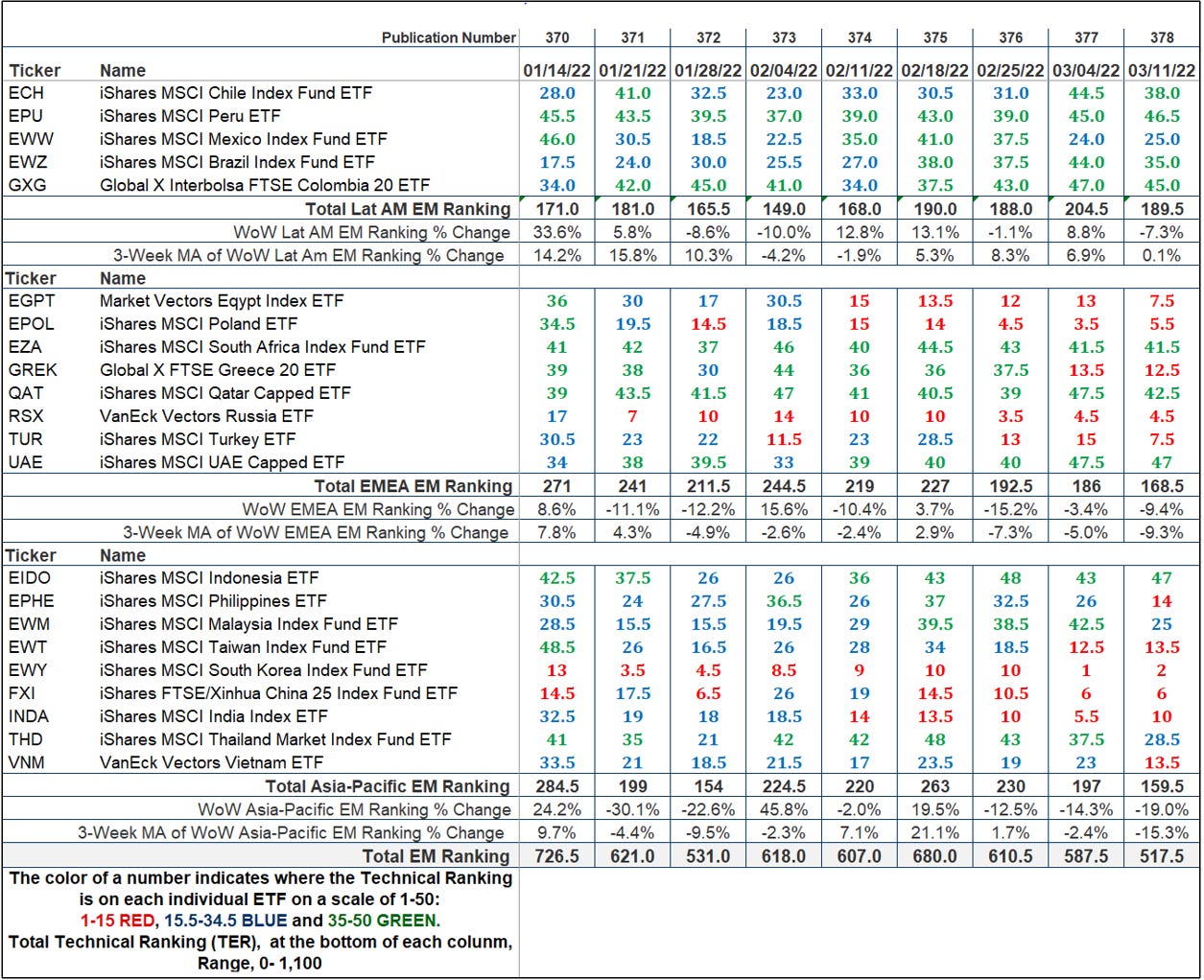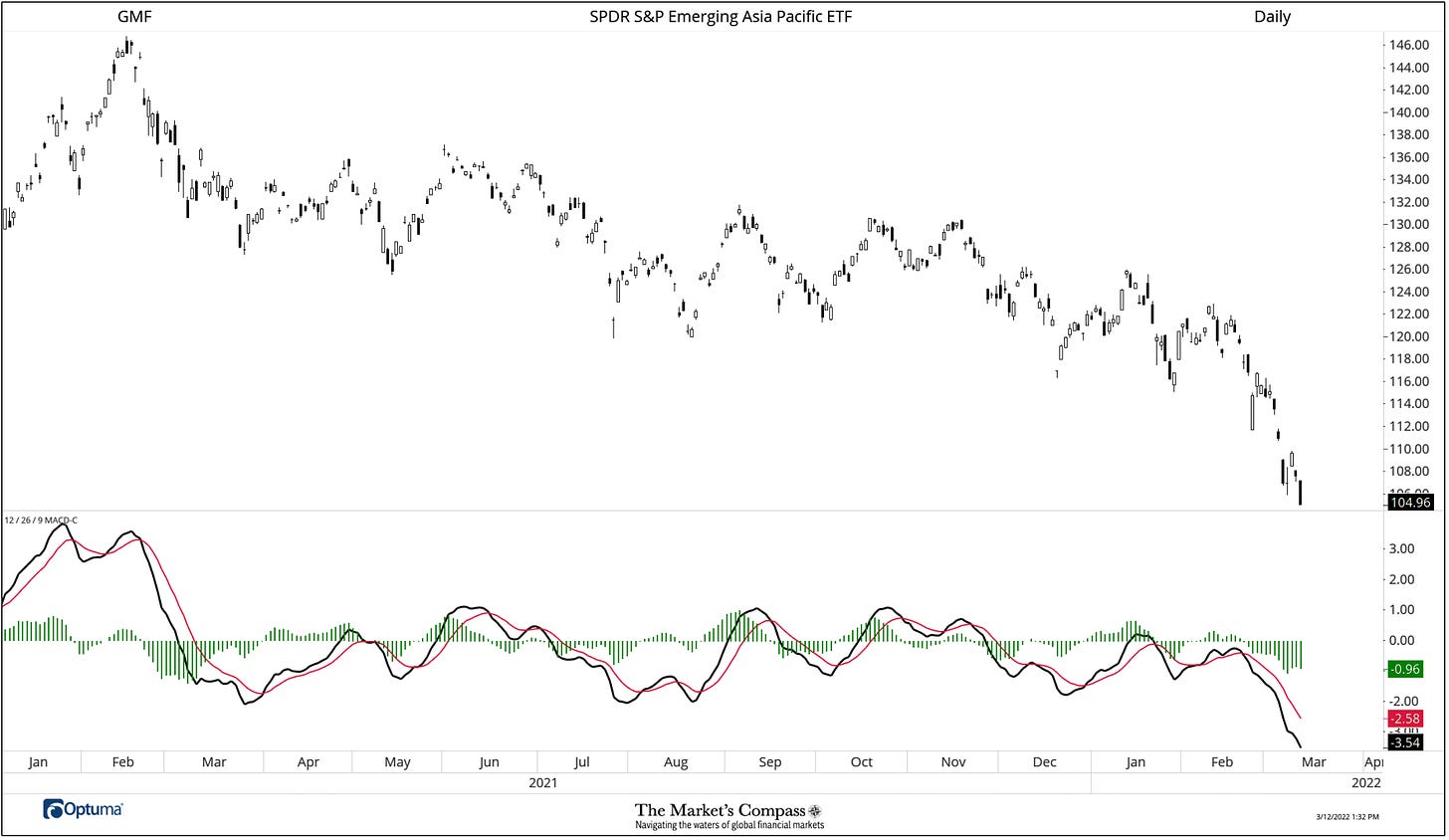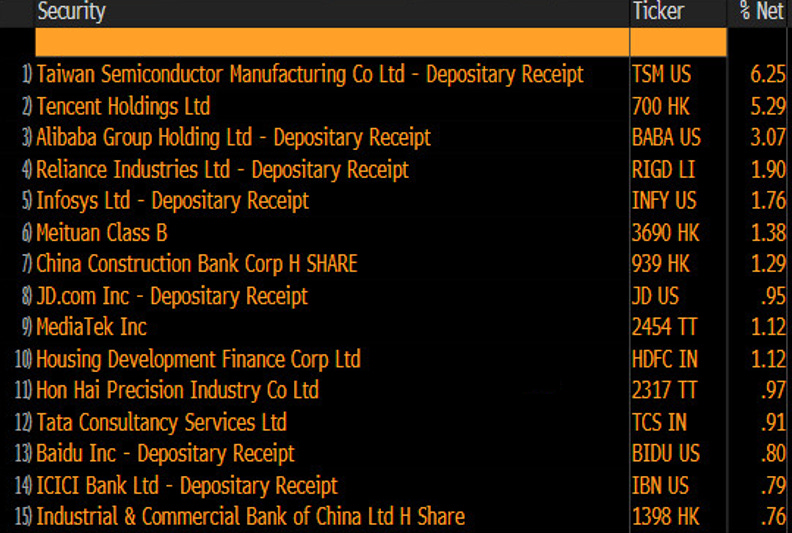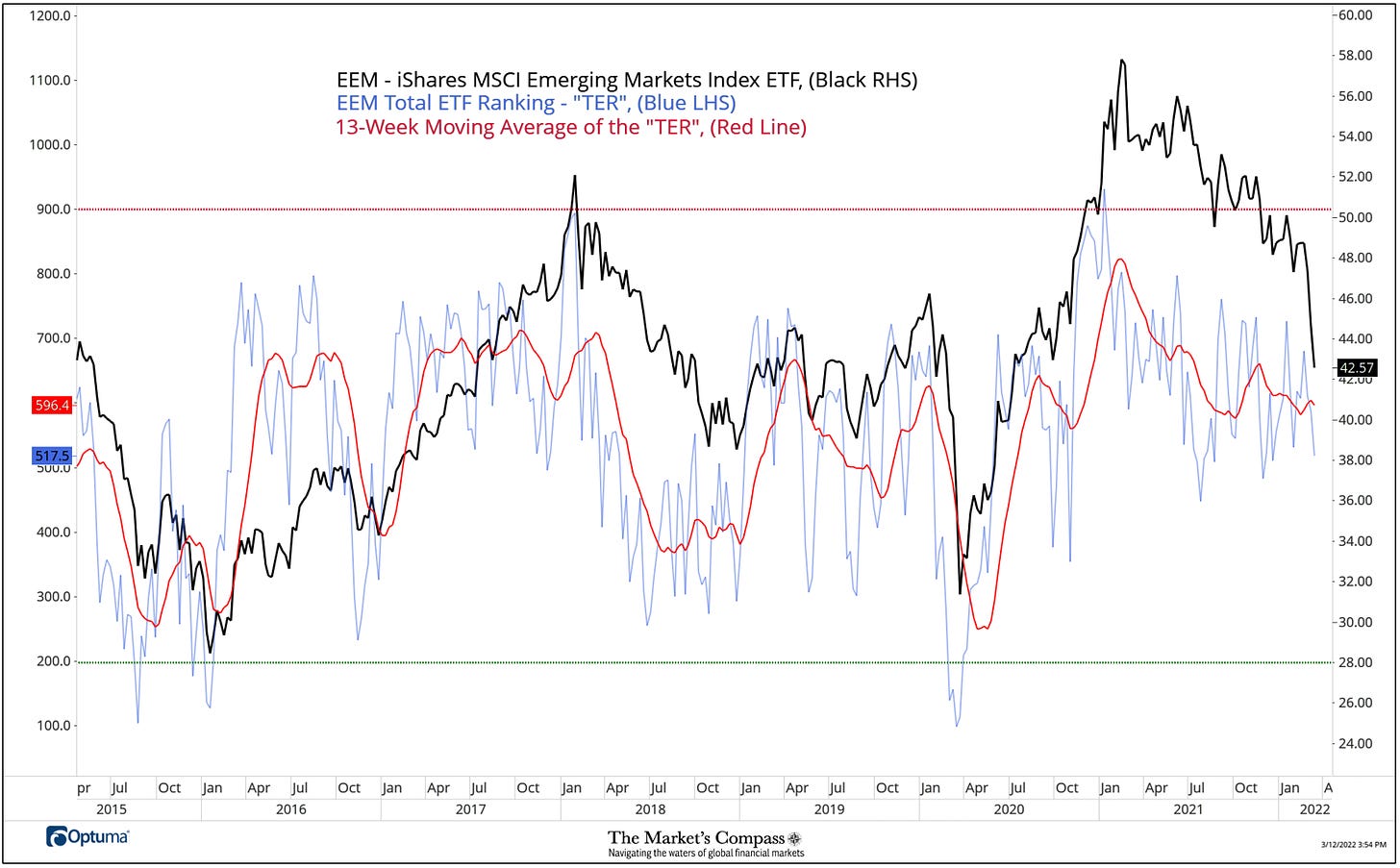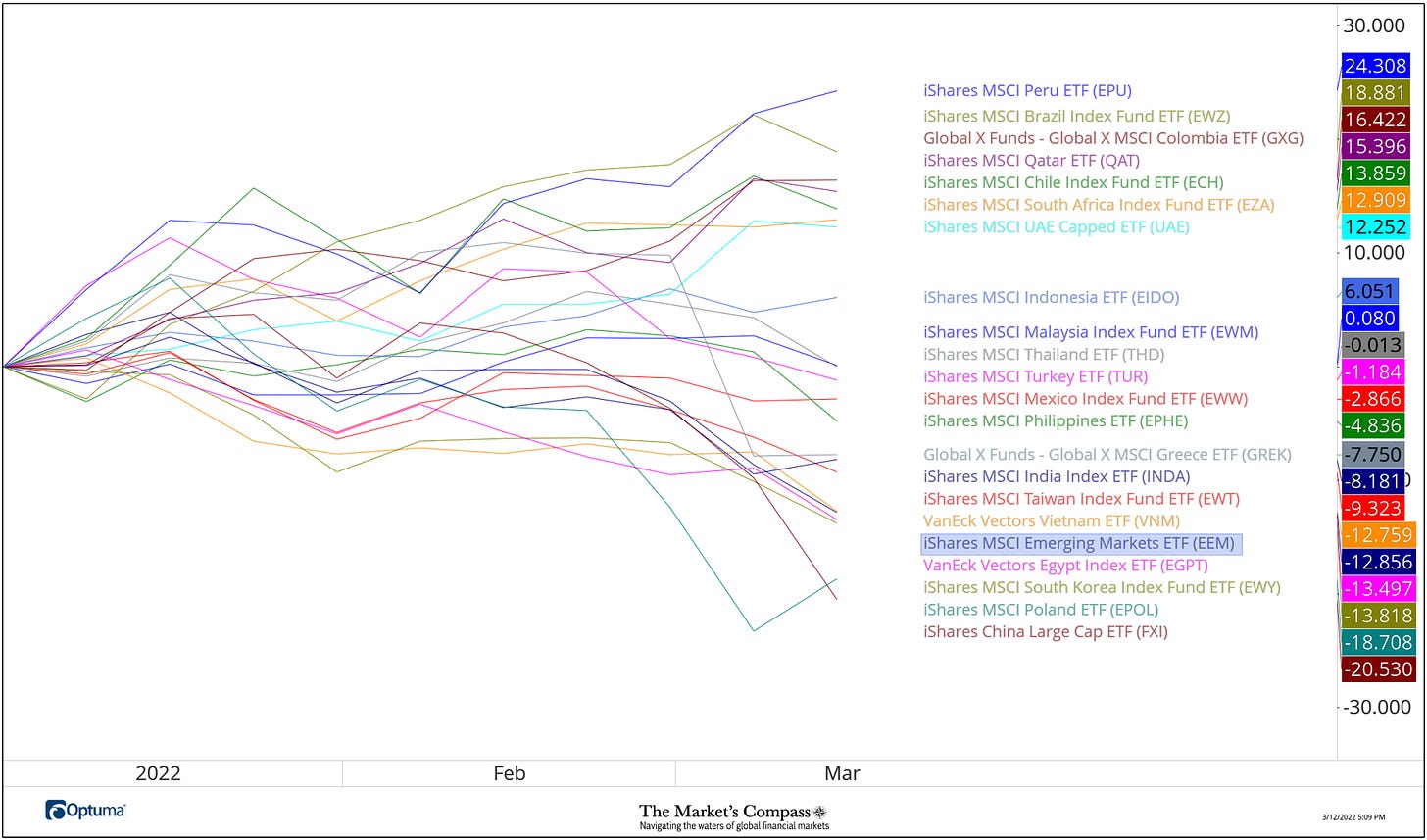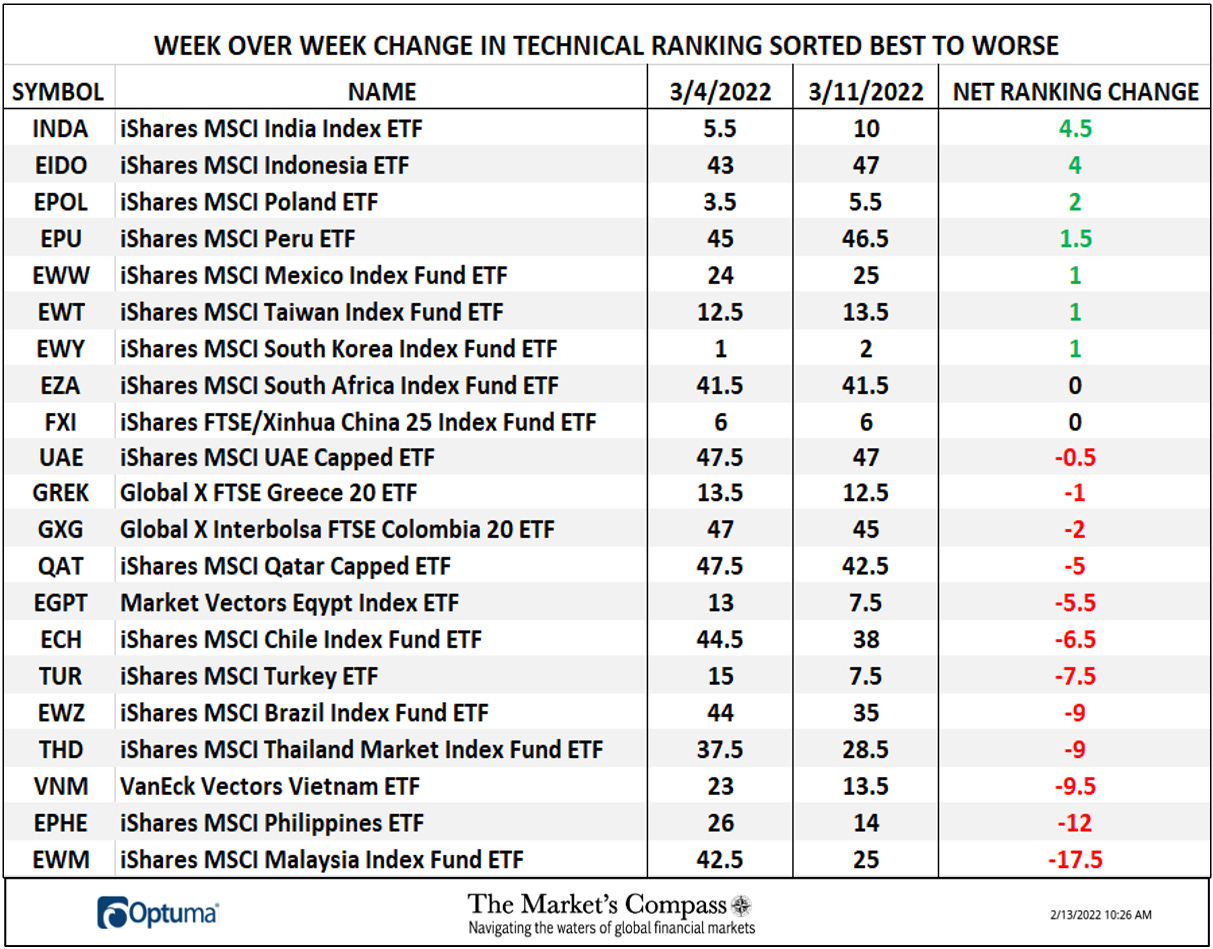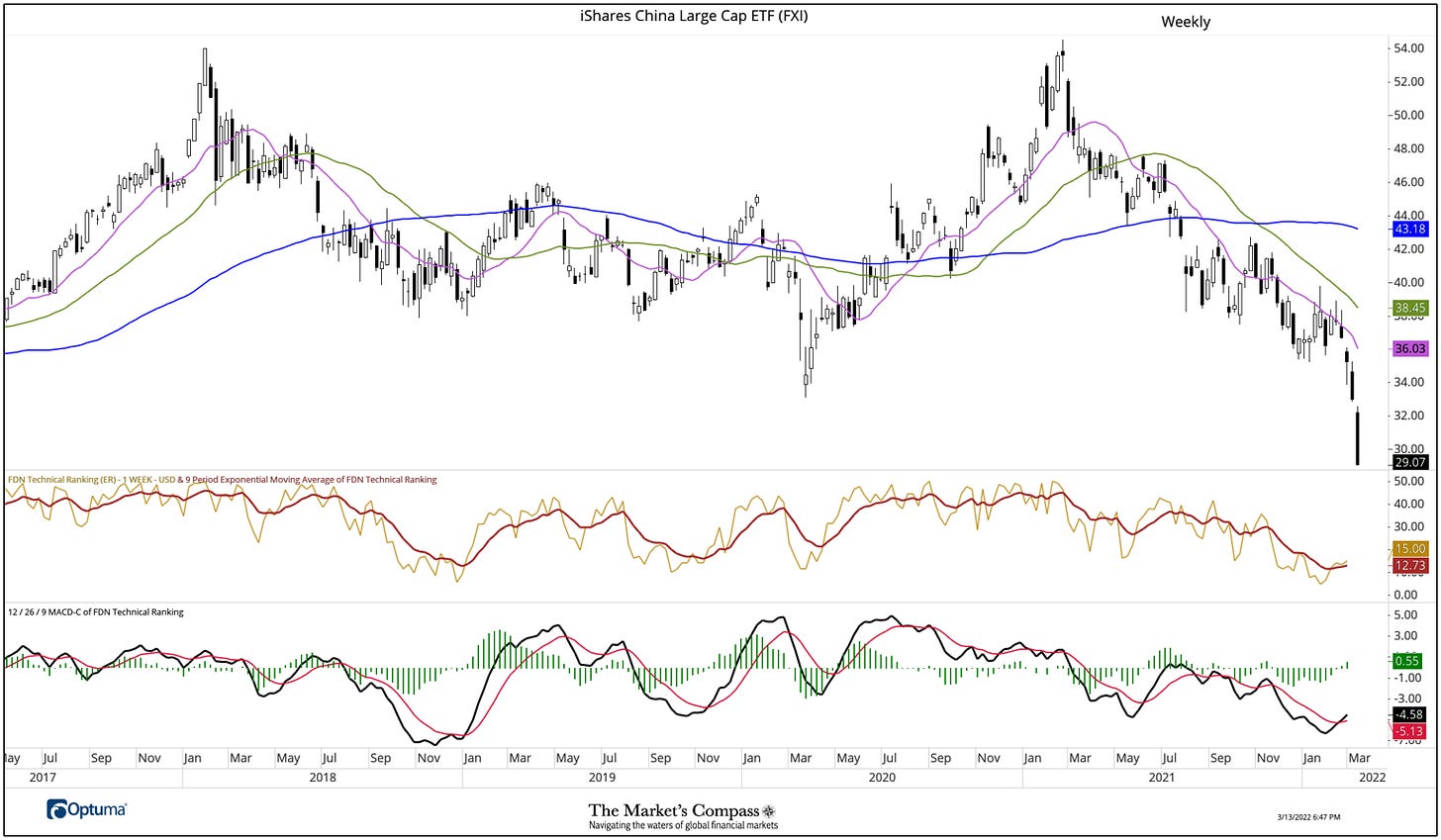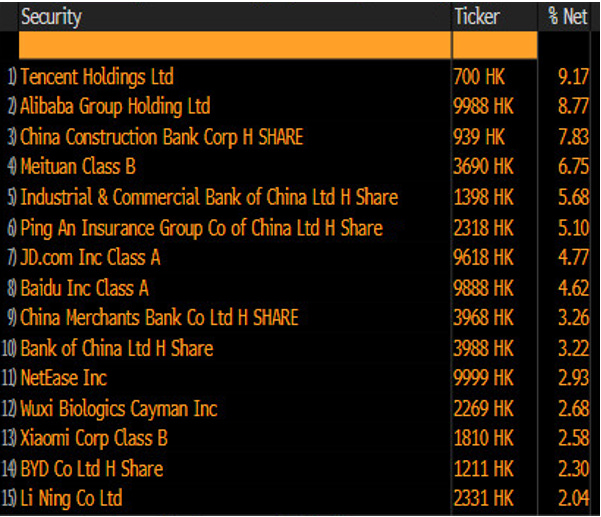This is the second publication of the Market’s Compass Emerging Markets Country ETF Study to be published in our Substack Blog that will highlight the technical changes of the 22 EM ETFs that we track on a weekly basis that also includes notes on the technical changes from our last published Market’s Compass EM Countries ETF Study three weeks ago on February 23rd. Past publications can be accessed via The Market’s Compass Substack Blog, The Market’s Compass website or by contacting us directly.
Last Week’s and 8 Week Trailing Technical Rankings of Individual ETFs
The Excel spreadsheet below indicates the weekly change in the Technical Ranking (“TR”) of each individual ETF. The technical ranking or scoring system is an entirely quantitative approach that utilizes multiple technical considerations that include but are not limited to trend, momentum, measurements of accumulation/distribution and relative strength. If an individual ETFs technical condition improves the Technical Ranking TR rises and conversely if the technical condition continues to deteriorate the TR falls. The TR of each individual ETF ranges from 0 to 50. The primary take away from this spread sheet should be the trend of the individual TRs either the continued improvement or deterioration, as well as a change in direction. Secondarily, a very low ranking can signal an oversold condition and conversely a continued very high number can be viewed as an overbought condition, but with due warning, over sold conditions can continue at apace and overbought securities that have exhibited extraordinary momentum can easily become more overbought. A sustained trend change needs to unfold in the TR for it to be actionable. The TR of each individual ETF in each of the three geographic regions can also reveal comparative relative strength or weakness of the technical condition of the select ETF in the same region.
As can be seen above, of the three Emerging Market Country regions we track, only the five Latin America Country ETFs have sported Technical Rankings (“TRs”) that have been above the “red zone” (above 15) for the past nine weeks leaving the Total Lat AM EM Ranking down virtually unchanged over the past three weeks from 190 to 189.5 (we highlighted the continued relative outperformance of the 5 Lat Am Country ETFs in our last EM Blog . The Total EMEA EM Ranking that includes 8 separate country ETF TRs has performed far worse over the same period (over the former), dropping 25.8% to 168.5 from 227. The poorest geographic region Total Ranking change since we published three weeks ago has been the Asia-Pacific EM Ranking that includes 9 separate country ETF TRs. The Asia-Pacific Total Ranking has fallen to 159.5 from 263, by 103.5 “handles” or 39.3% since the February 18th reading. The SPDR S&P Emerging Asia Pacific ETF (GMF) has accelerated lower over the past three weeks (chart presented below) and has been declining since the February 16th high of 146.78 to last week’s closing low of 104.96, a -28.5% drop. Note in the lower panel of the chart that MACD has been tracking sharply lower reflecting the recent speed of downside price momentum. Admittedly, the GMF is not a hugely liquid ETF (with a 90-day Aggregate Volume of 28,700 shares) but the chart of the ETF serves to represent the liquidation of the underlying equities in the Asia-Pac region. The panel following the chart of the GMF are the top 15 holdings in the ETF and are heavily weighted to Taiwanese, Chinese, and Indian equities facilitated by investments in Depositary Receipts.
The EEM with This Week’s Total ETF Ranking “TER” Overlayed
The Total ETF Ranking (“TER”) Indicator is a total of all 22 ETF rankings and can be looked at as a confirmation/divergence indicator as well as an overbought oversold indicator. As a confirmation/divergence tool: If the broader market as measured by the iShares MSCI Emerging Markets Index ETF (EEM) continues to rally without a commensurate move or higher move in the TE” the continued rally in the EEM Index becomes increasingly in jeopardy. Conversely, if the EEM continues to print lower lows and there is little change or a building improvement in the TER a positive divergence is registered. This is, in a fashion, is like a traditional A/D Line. As an overbought/oversold indicator: The closer the TER gets to the 1100 level (all 22 ETFs having a TR of 50) “things can’t get much better technically” and a growing number individual ETFs have become “stretched” the more of a chance of a pullback in the EEM. On the flip side the closer to an extreme low “things can’t get much worse technically” and a growing number of ETFs are “washed out technically” an oversold rally or measurable low is close to be in place. The 13-week exponential moving average in Red smooths the volatile TER readings and analytically is a better indicator of trend.
The EEM Total Technical Ranking (“TER”) of the 22 Emerging Market Country ETFs fell to 517.5 from 587.5, resulting in a +12.03% decrease week over week. Over the 3-week period since we last publish the Total EM Ranking fell -23.8% to 517.5 from 680. Although it was a sharp drop it was not commensurate with the EEM which fell 12.62% over the same period. We remind readers that because a good number EM ETFs are thinly traded and are subject to wide swings which in turn creates volatile individual Technical Ranking changes, that the calculation of the TER also fluctuates in a similar manor. Analytically, focusing on the 13-week moving average of the TER is a far better indicator. Although that moving average has not made a new low it is still trending lower, and as can be seen on the chart above, the series of higher lows in the TER since the July of last year was ameliorated with last weeks reading as the EEM has traded down sharply over the past three weeks. TER divergences take time to develop, and only if we begin to see price break out of the down trend or the TER decisively break out of the contracting triangle to higher highs would we be prepared to suggest that the EEM may be out of the woods.
The Average “TR” Ranking of the 22 Emerging Markets Country ETFs
The Average Weekly Technical Ranking (“ATR”) is the average Technical Ranking (“TR”) of the 22 Emerging Markets Country ETFs we track weekly and is plotted in the lower panel on the Weekly Candle Chart of the iShares MSCI Emerging Markets Index ETF (EEM) presented below. Like the “TER”, it is a confirmation/divergence or overbought/oversold indicator.
The Average Technical Ranking (“ATR”) of the 22 Emerging Markets Country ETFs fell last week but the trend, as can be seen by the longer-term moving average (blue line) remains flat in a sideways churn although the shorter-term moving average (red line) is beginning to hint at a turn lower. The EEM has been in a grinding downtrend since February that accelerated over the past three weeks. Over that period the EEM is down -12.6%. That said the ATR has avoided printing a lower low. This is a result of the Lat-Am TRs being elevated, with those removed this week’s ATR reading of the remaining 17 ETFs would be 19.29.
Absolute Performance of the 22 Emerging Market Countries ETFs Year to Date*
*Does not include dividends and the RSX which was down -78.80% before trading was halted.
More confirmation of the outperformance on the Lat AM Country ETFs since the start of the year are revealed on the chart above.
The Average “TR” Ranking of the 22 ETFs
The Average Weekly Technical Ranking (“ATR”) is the average Technical Ranking (“TR”) of the 22 Emerging Markets Country ETFs we track weekly and is plotted in the lower panel on the Weekly Candle Chart of the iShares MSCI Emerging Markets Index ETF (EEM) presented below. Like the “TER”, it is a confirmation/divergence or overbought/oversold indicator.
The Average Technical Ranking (“ATR”) of the 22 Emerging Markets Country ETFs fell last week but the trend, as can be seen by the longer-term moving average (blue line) remains flat in a sideways churn although the shorter-term moving average (red line) is beginning to hint at a turn lower. The EEM has been in a grinding downtrend since February that accelerated over the past three weeks. Over that period the EEM is down -12.6%. That said the ATR has avoided printing a lower low. This is a result of the Lat-Am TRs being elevated, with those removed this week’s ATR reading of the remaining 17 ETFs would be 19.29.
The Week Over Week Change in Technical Rankings*
*The RSX has been deleted from his week’s Week over Week changes in the TRs.
The three largest Technical Ranking drops were Asia-Pacific ETFs, the iShares MSCI Malaysia Index Fund ETF (EWM) falling -17.5 to 25 from 42.5 followed by the iShares MSCI Philippines ETF (EPHE) which dropped -12 to 14 from 26 and the VanEck Vectors Vietnam ETF (VNM) which fell -9.5 to 13.5 from 23. Data is courtesy of Optuma.
The Emerging Markets Country ETFs Weekly Absolute and Relative Price % Change*
*Does not including dividends, the VanEck Vectors Russia ETF (RSX) is again, omitted.
Eight of the 22 Emerging Markets Country ETFs we track improved on an absolute basis last week, led by the iShares MSCI Poland ETF (EPOL) up +6.01%. Seventeen EM ETFs outperformed the iShares MSCI Emerging Markets ETF (EEM) on a relative basis which was down -4.59% on the week On a relative basis 4 EM ETFs underperformed. The worst performing ETF on an absolute basis was the iShares China Large Cap ETF (FXI), down -11.83% on the week (the top 15 holdings in the ETF follow the weekly chart below). Data is courtesy of Bloomberg.
FXI Holdings
I invite our readers to contact me with any questions or comments at…tbrackett@themarketscompass.com




